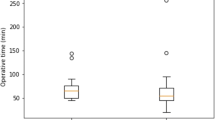Abstract
Background/purpose
We evaluated the usefulness of intraoperative exploration of the biliary anatomy using fluorescence imaging with indocyanine green (ICG) in experimental and clinical cholecystectomies.
Methods
The experimental study was done using two 40-kg pigs and the clinical study was done in 12 patients for whom cholecystectomy was planned from January 2009 to June 2009. Initially we used a laparoscopic approach for the evaluation of fluorescence imaging of the biliary system in the two pigs. Then the clinical study was started on the basis of these experimental results. ICG (1.0 ml/body of 2.5 mg/ml ICG) was infused 1–2 h before surgery. With the subjects under general anesthesia we observed in real time the condition of the biliary tract under the guidance of fluorescence imaging employing an infrared camera or a prototype laparoscope. ICG was added intravenously to observe the location or flow condition of the cystic artery.
Results
We obtained a clear view of the biliary tract and the location of the cystic duct in the two pigs. Local compression with a transparent hemispherical plastic device was effective for offering a clearer view. The biliary tract, except for the gallbladder, was clearly recognized in all clinical subjects. Local compression with a transparent hemispherical plastic device for open cholecystectomy and a flat plastic device for laparoscopy provided clearer visualization of the confluence between the cystic duct and common bile duct or common hepatic duct. The location of the cystic artery was revealed after division of the connective tissues, and the flow condition of the cystic artery was confirmed 7–10 s after intravenous re-infusion of ICG. There were no adverse events related to the intraoperative procedure or the ICG itself.
Conclusions
This method is safe and easy for the identification of the biliary anatomy, without requiring cannulation into the cystic duct, X-ray equipment, or the use of radioactive materials. Although fluorescence imaging is still at an early stage of application in comparison with ordinary intraoperative cholangiography, we expect that this method will become routine, offering a lower degree of invasiveness that will help avoid bile duct injury.








Similar content being viewed by others
References
Benya R, Quintana J, Brundage B. Adverse reactions to indocyanine green: a case report and a review of the literature. Cathet Cardiovasc Diagn. 1989;17:231–3.
Hope-Ross M, Yannuzzi LA, Gragoudas ES, Guyer DR, Slakter JS, Sorenson JA, et al. Adverse reactions due to indocyanine green. Ophthalmology. 1994;101:529–33.
Kitai T, Inomoto T, Miwa M, Shikayama T. Fluorescence navigation with indocyanine green for detecting sentinel lymph nodes in breast cancer. Breast Cancer. 2005;12:211–5.
Tagaya N, Yamazaki R, Nakagawa A, Abe A, Hamada K, Kubota K, et al. Intraoperative identification of sentinel lymph nodes by near-infrared fluorescence imaging in patients with breast cancer. Am J Surg. 2008;195:850–3.
Kusano M, Tajima Y, Yamazaki K, Kato M, Watanabe M, Miwa M. Sentinel node mapping guided by indocyanine green fluorescence imaging: a new method for sentinel node navigation surgery in gastrointestinal cancer. Dig Surg. 2008;25:103–8.
Kubota K, Kita J, Shimoda M, Rokkaku K, Kato M, Iso Y, et al. Intraoperative assessment of reconstructed vessels in living-donor liver transplantation, using a novel fluorescence imaging technique. J Hepatobiliary Pancreat Surg. 2006;13:100–4.
Unno N, Inuzuka K, Suzuki M, Yamamoto N, Sagara D, Nishiyama M, et al. Preliminary experience with a novel fluorescence lymphography using indocyanine green in patients with secondary lymphedema. J Vasc Surg. 2007;45:1016–21.
Stiles BM, Adusumilli PS, Bhargava A, Fong Y. Fluorescence cholangiography in a mouse model; an innovative method for improved laparoscopic identification of the biliary anatomy. Surg Endosc. 2006;20:1291–5.
Tanaka E, Choi HS, Humblet V, Ohnishi S, Laurence RG, Frangioni JV. Real-time intraoperative assessment of the extrahepatic bile ducts in rats and pigs using invisible near-infrared fluorescent light. Surgery. 2008;144:39–48.
Mitsuhashi N, Kimura F, Shimizu H, Imamaki M, Yoshidome H, Ohtsuka M, et al. Usefulness of intraoperative fluorescence imaging to evaluate local anatomy in hepatobiliary surgery. J Hepatobilary Pancreat Surg. 2008;15:508–14.
Harada K, Miwa M, Fukuyo T, Watanabe S, Enosawa S, Chiba T. ICG florescence endoscope for visualization of the placental vascular network. Minim Invasive Ther Allied Technol. 2009;18:3–7.
Fox IJ, Wood EH. Indocyanine green: physical and physiological properties. Proc Staff Meet Mayo Clin. 1960;35:732–44.
Author information
Authors and Affiliations
Corresponding author
About this article
Cite this article
Tagaya, N., Shimoda, M., Kato, M. et al. Intraoperative exploration of biliary anatomy using fluorescence imaging of indocyanine green in experimental and clinical cholecystectomies. J Hepatobiliary Pancreat Sci 17, 595–600 (2010). https://doi.org/10.1007/s00534-009-0195-2
Received:
Accepted:
Published:
Issue Date:
DOI: https://doi.org/10.1007/s00534-009-0195-2




